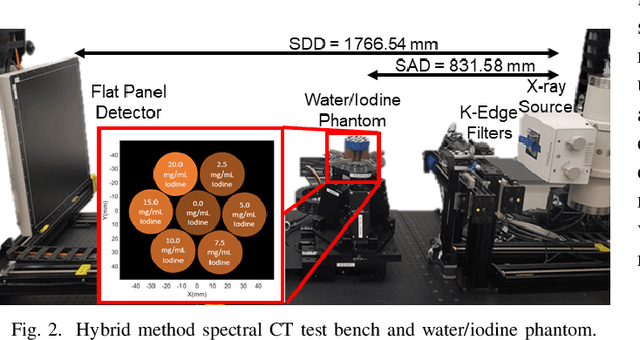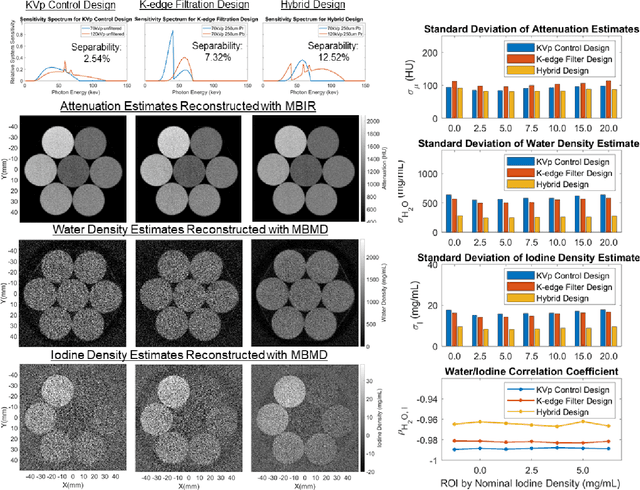Matthew Tivnan
Prediction of Frozen Region Growth in Kidney Cryoablation Intervention Using a 3D Flow-Matching Model
Mar 06, 2025Abstract:This study presents a 3D flow-matching model designed to predict the progression of the frozen region (iceball) during kidney cryoablation. Precise intraoperative guidance is critical in cryoablation to ensure complete tumor eradication while preserving adjacent healthy tissue. However, conventional methods, typically based on physics driven or diffusion based simulations, are computationally demanding and often struggle to represent complex anatomical structures accurately. To address these limitations, our approach leverages intraoperative CT imaging to inform the model. The proposed 3D flow matching model is trained to learn a continuous deformation field that maps early-stage CT scans to future predictions. This transformation not only estimates the volumetric expansion of the iceball but also generates corresponding segmentation masks, effectively capturing spatial and morphological changes over time. Quantitative analysis highlights the model robustness, demonstrating strong agreement between predictions and ground-truth segmentations. The model achieves an Intersection over Union (IoU) score of 0.61 and a Dice coefficient of 0.75. By integrating real time CT imaging with advanced deep learning techniques, this approach has the potential to enhance intraoperative guidance in kidney cryoablation, improving procedural outcomes and advancing the field of minimally invasive surgery.
Pseudoinverse Diffusion Models for Generative CT Image Reconstruction from Low Dose Data
Feb 20, 2025Abstract:Score-based diffusion models have significantly advanced generative deep learning for image processing. Measurement conditioned models have also been applied to inverse problems such as CT reconstruction. However, the conventional approach, culminating in white noise, often requires a high number of reverse process update steps and score function evaluations. To address this limitation, we propose an alternative forward process in score-based diffusion models that aligns with the noise characteristics of low-dose CT reconstructions, rather than converging to white noise. This method significantly reduces the number of required score function evaluations, enhancing efficiency and maintaining familiar noise textures for radiologists, Our approach not only accelerates the generative process but also retains CT noise correlations, a key aspect often criticized by clinicians for deep learning reconstructions. In this work, we rigorously define a matrix-controlled stochastic process for this purpose and validate it through computational experiments. Using a dataset from The Cancer Genome Atlas Liver Hepatocellular Carcinoma (TCGA-LIHC), we simulate low-dose CT measurements and train our model, comparing it with a baseline scalar diffusion process and conditional diffusion model. Our results demonstrate the superiority of our pseudoinverse diffusion model in terms of efficiency and the ability to produce high-quality reconstructions that are familiar in texture to medical professionals in a low number of score function evaluations. This advancement paves the way for more efficient and clinically practical diffusion models in medical imaging, particularly beneficial in scenarios demanding rapid reconstructions or lower radiation exposure.
Rethinking Visual Counterfactual Explanations Through Region Constraint
Oct 16, 2024Abstract:Visual counterfactual explanations (VCEs) have recently gained immense popularity as a tool for clarifying the decision-making process of image classifiers. This trend is largely motivated by what these explanations promise to deliver -- indicate semantically meaningful factors that change the classifier's decision. However, we argue that current state-of-the-art approaches lack a crucial component -- the region constraint -- whose absence prevents from drawing explicit conclusions, and may even lead to faulty reasoning due to phenomenons like confirmation bias. To address the issue of previous methods, which modify images in a very entangled and widely dispersed manner, we propose region-constrained VCEs (RVCEs), which assume that only a predefined image region can be modified to influence the model's prediction. To effectively sample from this subclass of VCEs, we propose Region-Constrained Counterfactual Schr\"odinger Bridges (RCSB), an adaptation of a tractable subclass of Schr\"odinger Bridges to the problem of conditional inpainting, where the conditioning signal originates from the classifier of interest. In addition to setting a new state-of-the-art by a large margin, we extend RCSB to allow for exact counterfactual reasoning, where the predefined region contains only the factor of interest, and incorporating the user to actively interact with the RVCE by predefining the regions manually.
Hallucination Index: An Image Quality Metric for Generative Reconstruction Models
Jul 17, 2024Abstract:Generative image reconstruction algorithms such as measurement conditioned diffusion models are increasingly popular in the field of medical imaging. These powerful models can transform low signal-to-noise ratio (SNR) inputs into outputs with the appearance of high SNR. However, the outputs can have a new type of error called hallucinations. In medical imaging, these hallucinations may not be obvious to a Radiologist but could cause diagnostic errors. Generally, hallucination refers to error in estimation of object structure caused by a machine learning model, but there is no widely accepted method to evaluate hallucination magnitude. In this work, we propose a new image quality metric called the hallucination index. Our approach is to compute the Hellinger distance from the distribution of reconstructed images to a zero hallucination reference distribution. To evaluate our approach, we conducted a numerical experiment with electron microscopy images, simulated noisy measurements, and applied diffusion based reconstructions. We sampled the measurements and the generative reconstructions repeatedly to compute the sample mean and covariance. For the zero hallucination reference, we used the forward diffusion process applied to ground truth. Our results show that higher measurement SNR leads to lower hallucination index for the same apparent image quality. We also evaluated the impact of early stopping in the reverse diffusion process and found that more modest denoising strengths can reduce hallucination. We believe this metric could be useful for evaluation of generative image reconstructions or as a warning label to inform radiologists about the degree of hallucinations in medical images.
Conditional Score-Based Diffusion Model for Cortical Thickness Trajectory Prediction
Mar 11, 2024Abstract:Alzheimer's Disease (AD) is a neurodegenerative condition characterized by diverse progression rates among individuals, with changes in cortical thickness (CTh) closely linked to its progression. Accurately forecasting CTh trajectories can significantly enhance early diagnosis and intervention strategies, providing timely care. However, the longitudinal data essential for these studies often suffer from temporal sparsity and incompleteness, presenting substantial challenges in modeling the disease's progression accurately. Existing methods are limited, focusing primarily on datasets without missing entries or requiring predefined assumptions about CTh progression. To overcome these obstacles, we propose a conditional score-based diffusion model specifically designed to generate CTh trajectories with the given baseline information, such as age, sex, and initial diagnosis. Our conditional diffusion model utilizes all available data during the training phase to make predictions based solely on baseline information during inference without needing prior history about CTh progression. The prediction accuracy of the proposed CTh prediction pipeline using a conditional score-based model was compared for sub-groups consisting of cognitively normal, mild cognitive impairment, and AD subjects. The Bland-Altman analysis shows our diffusion-based prediction model has a near-zero bias with narrow 95% confidential interval compared to the ground-truth CTh in 6-36 months. In addition, our conditional diffusion model has a stochastic generative nature, therefore, we demonstrated an uncertainty analysis of patient-specific CTh prediction through multiple realizations.
Implicit Image-to-Image Schrodinger Bridge for CT Super-Resolution and Denoising
Mar 10, 2024Abstract:Conditional diffusion models have gained recognition for their effectiveness in image restoration tasks, yet their iterative denoising process, starting from Gaussian noise, often leads to slow inference speeds. As a promising alternative, the Image-to-Image Schr\"odinger Bridge (I2SB) initializes the generative process from corrupted images and integrates training techniques from conditional diffusion models. In this study, we extended the I2SB method by introducing the Implicit Image-to-Image Schrodinger Bridge (I3SB), transitioning its generative process to a non-Markovian process by incorporating corrupted images in each generative step. This enhancement empowers I3SB to generate images with better texture restoration using a small number of generative steps. The proposed method was validated on CT super-resolution and denoising tasks and outperformed existing methods, including the conditional denoising diffusion probabilistic model (cDDPM) and I2SB, in both visual quality and quantitative metrics. These findings underscore the potential of I3SB in improving medical image restoration by providing fast and accurate generative modeling.
Diffusion Posterior Sampling for Nonlinear CT Reconstruction
Dec 03, 2023Abstract:Diffusion models have been demonstrated as powerful deep learning tools for image generation in CT reconstruction and restoration. Recently, diffusion posterior sampling, where a score-based diffusion prior is combined with a likelihood model, has been used to produce high quality CT images given low-quality measurements. This technique is attractive since it permits a one-time, unsupervised training of a CT prior; which can then be incorporated with an arbitrary data model. However, current methods only rely on a linear model of x-ray CT physics to reconstruct or restore images. While it is common to linearize the transmission tomography reconstruction problem, this is an approximation to the true and inherently nonlinear forward model. We propose a new method that solves the inverse problem of nonlinear CT image reconstruction via diffusion posterior sampling. We implement a traditional unconditional diffusion model by training a prior score function estimator, and apply Bayes rule to combine this prior with a measurement likelihood score function derived from the nonlinear physical model to arrive at a posterior score function that can be used to sample the reverse-time diffusion process. This plug-and-play method allows incorporation of a diffusion-based prior with generalized nonlinear CT image reconstruction into multiple CT system designs with different forward models, without the need for any additional training. We develop the algorithm that performs this reconstruction, including an ordered-subsets variant for accelerated processing and demonstrate the technique in both fully sampled low dose data and sparse-view geometries using a single unsupervised training of the prior.
High-Sensitivity Iodine Imaging by Combining Spectral CT Technologies
Mar 29, 2021


Abstract:Spectral CT offers enhanced material discrimination over single-energy systems and enables quantitative estimation of basis material density images. Water/iodine decomposition in contrast-enhanced CT is one of the most widespread applications of this technology in the clinic. However, low concentrations of iodine can be difficult to estimate accurately, limiting potential clinical applications and/or raising injected contrast agent requirements. We seek high-sensitivity spectral CT system designs which minimize noise in water/iodine density estimates. In this work, we present a model-driven framework for spectral CT system design optimization to maximize material separability. We apply this tool to optimize the sensitivity spectra on a spectral CT test bench using a hybrid design which combines source kVp control and k-edge filtration. Following design optimization, we scanned a water/iodine phantom with the hybrid spectral CT system and performed dose-normalized comparisons to two single-technique designs which use only kVp control or only kedge filtration. The material decomposition results show that the hybrid system reduces both standard deviation and crossmaterial noise correlations compared to the designs where the constituent technologies are used individually.
 Add to Chrome
Add to Chrome Add to Firefox
Add to Firefox Add to Edge
Add to Edge